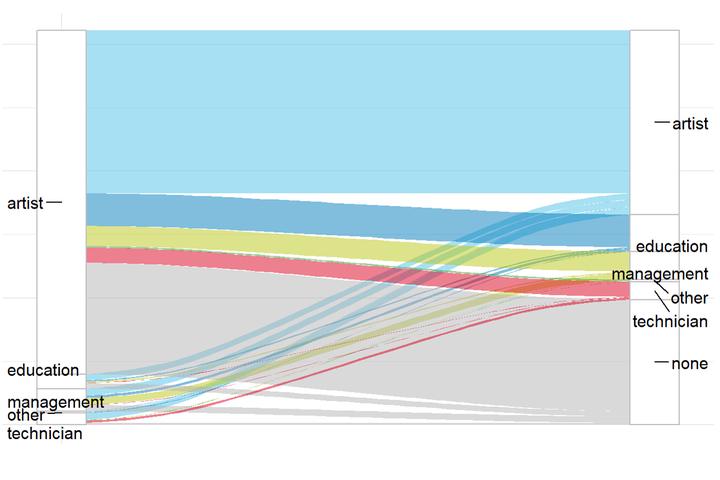Music Economy
Indicators related to the music economy

In the case of Pillar 1 – Music & Economy, we are usually able to
locate the source of the data, and we have some experience in processing
the data and bringing it to light. We have mapped many perceived data
gaps to the various data harmonization projects of GESAC and CISAC, and
we will seek cooperation with these organizations and their members to
find a secure and voluntary way to retrieve the data.
In other cases, we will rely on on the 2019/1024/EU Open Data Directive to access, process, document, and disseminate the data.
The music.dataobservatory.eu monitors the music markets with an economic methodology: we not only measure market volumes and prices, but we also measure both demand- and supply side indicators so that we can forecast future market volumes or prices. (See Innovation pillar — 4.2 Forecasting)
Music is not a purely market activity. Music and music services have consumers who pay for it one way or another, but there are non-market forms of music (for example, in liturgy) and music markets are overshadowed by a very large illegal market. Therefore, instead of “music consumption” we use the more appropriate statistical terms of access and participation. we do measure non-market form,s but currently we do not address teh data gap the “impact of the non-profit sector”.
Pillar 1 - Music Economy | |||
|---|---|---|---|
Topic | Description | ||
| pillar | problem | availability | feasibility |
| Pillar 1 | Value of music sector | One-off | EY study on the cultural and creative industries (2015) |
| Pillar 1 | Value of music sector | One-off or one recast | CEEMID studies on national music economies |
| Pillar 1 | Employment | One-off | EY study on the cultural and creative industries (2015) |
| Pillar 1 | Employment | One-off or one recast | CEEMID national music industry reports |
| Pillar 1 | Employment | Annual | Eurostat, lacking granularity |
| Pillar 1 | Employment | Data gap | Absence of granularity on the employment of the various sub-sectors, in particular in defining the roles of the various sub-sectors and the importance of the not-for-profit sector in terms of employment. |
| Pillar 1 | Employment | Data gap | HU, SK pilot successful to add granularity. |
| Pillar 1 | Value of music sector | Data gap | No EU-level assessment since 2015 |
| Pillar 1 | Strucutre of the market | Data gap | Absence of pan-European data detailing the number of companies, employees, revenues for the sector and the subsectors. |
| Pillar 1 | The impact of the not-forprofit sector on the overall economy of the music sector | Data gap | No data available on the specific impact of the not-for-profit sector, especially in the live music sub-sector |
| Pillar 1 | Recorded music | Subject to partnership with IFPI | IFPI |
| Pillar 1 | Authors and publisher’s stream | CISAC partnership | CISAC |
| Pillar 1 | Authors and publisher’s stream | GESAC | GESAC |
| Pillar 1 | Recorded music stream - performer rights | Data gap | No aggregated data on neighbouring rights collections Partner with AEPO-ARTIS and SCAP. |
| Pillar 1 | Music publishing | Data gap | No aggregated data on the music European music publishing business |
| Pillar 1 | Synchronisation rights | Data gap | IFPI data available on the recorded music side but not on the publishing side. |
| Pillar 1 | Independent music companies | Data gap | No aggregated data on the independent music sector (value, number of companies, employees, etc.) |
| Pillar 1 | Live music | Data gap | Some data is compiled by Live DMA, ETEP or Yourope, but there is no aggregated data on the pan-European live music sector listing the value of the market, the number and size of venues and shows, number of festivals, share of European artists, among other data points. |
| Pillar 1 | Exports | Data gap | No pan-European data on the export flows between EU countries and outside the EU. |
| Pillar 1 | Exports | Data gap | Embedded cultural tourism export. |
| Pillar 1 | Music retail | Data gap | Granular data on some countries via retail associations (UK, France, Germany) but no pan-European aggregated data. |
| Pillar 1 | Financing of the music sector | Data gap | No aggregated data on how the sector is financed (from investment fund to bank loans and subsidies). |
| Pillar 1 | Live music regulation | Data gap | No aggregated information available on the various legal and tax systems within the EU applied to the live music sector. |
| Pillar 1 | Copyright regulations and evolution of copyright regimes | Data gap | Although many copyright laws applicable in Europe originate from the Commission, there are few instruments available to monitor the state of copyright regulation across the EU |